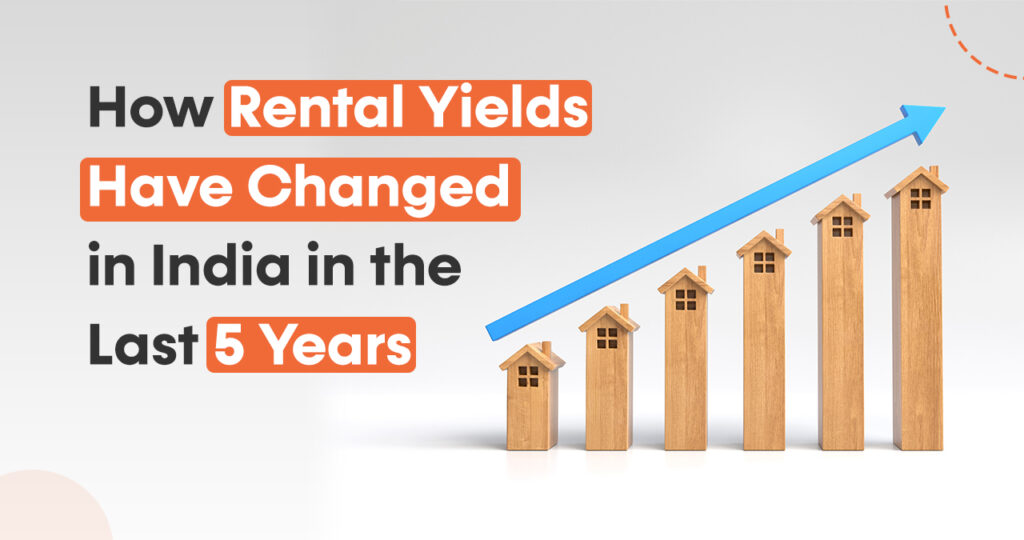The Indian real estate market is a dynamic and ever-evolving sector, driven by rapid urbanization, economic growth, and shifting demographic trends. A crucial indicator of profitability for investors is rental yield, which is a vital metric that expresses the annual rental revenue as a percentage of a property’s value. Over the past five years, from 2020 to 2025, rental yields in India have undergone significant changes, influenced by economic recovery, post-pandemic demand, inflation, and evolving buyer preferences. This article explores how rental yields have transformed in the Indian real estate market, with a focus on residential and commercial properties, key cities, and strategies to maximize returns.
Understanding Rental Yield in India
Rental yield is calculated using the formula:
Rental Yield = (Annual Rental Income / Property Value) x 100
There are two types of rental yields:
- Gross Rental Yield: Calculated before deducting expenses like maintenance, taxes, and insurance.
- Net Rental Yield: Accounts for all property-related expenses, providing a more accurate picture of returns.
In India, rental yields have historically been lower than in many global markets, often ranging between 2-4% for residential properties and 5-10% for commercial properties. However, the past five years have seen notable shifts due to market dynamics, government policies, and changing tenant preferences.
The Pre-Pandemic Baseline (2019-2020)
Before the COVID-19 pandemic, rental yields in India were relatively stagnant, with the national average hovering around 3% for residential properties. Major cities like Mumbai, Delhi-NCR, and Bengaluru reported yields between 2-3%, while commercial properties, particularly office spaces in IT hubs, offered higher yields of 6-8%. Several factors contributed to this scenario:
- High Property Prices: In metropolitan cities, skyrocketing property prices outpaced rental growth, keeping yields low.
- Stable Rental Demand: Urban migration and job opportunities in cities like Bengaluru and Hyderabad sustained rental demand, but oversupply in some markets limited rental price hikes.
- Economic Stability: India’s economy was growing steadily, with home loan rates around 7-8%, making property ownership more accessible but capping rental yield growth.
According to Anarock Research, Bengaluru led with a rental yield of 3.6% in 2019, followed by Mumbai at 3.2%. However, yields in oversaturated markets like Navi Mumbai and Thane were as low as 2.7-2.8%.
The Impact of the COVID-19 Pandemic (2020-2021)
Rental returns were greatly impacted by the COVID-19 pandemic’s disruption of the Indian real estate market. With lockdowns, remote work, and economic uncertainty, rental demand plummeted, particularly in urban centers. Key changes included:
- Decline in Rental Income: As professionals and students returned to their hometowns, rental demand in cities like Mumbai, Delhi, and Bengaluru dropped by 20-40% in 2020. Home sales in seven major cities fell to 1.38 lakh units in 2020 from 2.61 lakh units in 2019, reflecting a broader market slowdown.
- Shift to Suburban Markets: With work-from-home becoming the norm, tenants sought affordable rentals in suburban areas like Thane, Navi Mumbai, and Greater Noida, where yields were slightly higher (3-3.5%) due to lower property prices.
- Commercial Sector Challenges: The commercial real estate market faced a severe downturn as offices remained vacant. Rental yields for office spaces dropped from 6-8% to 4-6% in many cities, with vacancy rates rising sharply.
- Government Interventions: The Reserve Bank of India (RBI) reduced repo rates to stimulate the economy, lowering home loan rates to 6.5-7%. This encouraged property purchases but did little to boost rental yields in the short term.
Despite these challenges, affordable housing segments in tier-2 cities like Ahmedabad and Lucknow maintained relatively stable yields of 3-4%, driven by consistent demand from middle-income groups.
Post-Pandemic Recovery and Growth (2022-2023)
The real estate market began recovering in 2021, with a strong rebound in 2022. As offices reopened and urban migration resumed, rental demand surged, driving up yields. Key trends included:
- Residential Yield Growth: By September 2023, Bengaluru emerged as the leader with a rental yield of 4.35%, up from 3.6% in 2019. Mumbai followed with 4.05%, a 19% increase over five years. Navi Mumbai and Thane also saw improvements, with yields rising to 3.35% and 3.15%, respectively.
- Commercial Sector Resilience: The commercial real estate market bounced back, particularly in IT-driven cities like Bengaluru, Hyderabad, and Pune. Office space leasing reached 14.8 million square feet in Q2 2023, the highest since Q1 2021. Commercial yields stabilized at 7-8%, with some micro-markets offering up to 10%.
- Rental Price Hikes: Rental values in top cities soared by over 30% year-on-year in 2023. For instance, Hyderabad’s HITECH City saw a 5% rental increase, while Chennai’s rental growth was steady at 7%.
- Luxury Segment Surge: The luxury housing market, driven by high-net-worth individuals and non-resident Indians (NRIs), saw a 53% increase in sales in 2024, boosting rental demand for premium properties. However, yields in this segment remained lower (2-3%) due to high property costs.
- Policy Support: Government initiatives like the Smart Cities Mission and affordable housing programs under PMAY-U (119.7 lakh houses sanctioned by June 2023) supported rental demand in emerging markets.
Current Trends in Rental Yields (2024-2025)
As of Q1 2024, the Indian real estate market has shown remarkable resilience, with rental yields reflecting a competitive landscape. Here’s a snapshot of the current scenario:
- City-Wise Rental Yields:
- Bengaluru: Leads with a gross rental yield of 7.75%, driven by its robust IT sector and demand for office and residential spaces.
- Mumbai: Offers 7.75%, with premium localities like Chembur and Mulund seeing 4% rental growth.
- Delhi-NCR: Achieves yields of around 8%, the highest among major cities, due to strong demand in Gurugram and Noida.
- Kolkata: Provides a competitive yield of 5.03%, making it attractive for investors.
- Hyderabad: Yields 3.88%, with high demand in areas like HITECH City and Gachibowli.
- Chennai: Offers yields of around 5%, supported by stable rental growth.
- Pune: Yields range from 2.3% to 6.31%, depending on locality and amenities.
- Residential vs. Commercial Yields: Residential yields have improved to 3.5-4.5% in key cities, but commercial properties continue to outperform, with net yields of 7-8%. Office spaces and retail shops in Bengaluru and Mumbai are particularly lucrative.
- Micro-Market Opportunities: Micro-markets in affordable localities like Kolkata’s Garia, Bengaluru’s BTM Layout, and Hyderabad’s Nallagandla offer yields of 3.8-4.5%, higher than the national average.
- Inflation and Cost-of-Living Pressures: Average rents in top cities jumped by 4-9% in Q1 2024, reflecting cost-of-living inflation. While this benefits landlords, it poses challenges for tenants.
- Emerging Trends:
- Co-Living Spaces: Popular among millennials, co-living spaces in cities like Bengaluru and Delhi offer yields of 4-5% due to high occupancy rates.
- Furnished Apartments: Furnishing rentals increase yields by 0.3-0.5%, as tenants are willing to pay a premium for convenience.
- Smart City Developments: Cities on the government’s Smart Cities list, such as Ahmedabad and Bhopal, are seeing higher yields due to infrastructure improvements.
Also Read - Top 10 Best Affordable Areas to Live in Gurgaon on Rent
Also Read - Top 10 Best Affordable Areas to Live in Bengaluru on Rent
Factors Driving Changes in Rental Yields
Several factors have shaped the evolution of rental yields over the past five years:
- Urbanization and Job Mobility: India’s urban population is projected to reach 600 million by 2030, driving rental demand in metropolitan and tier-2 cities. High job mobility, especially in IT and finance sectors, has boosted yields in Bengaluru, Hyderabad, and Gurugram.
- Economic Growth: India’s economy is expected to grow at 7-8% annually, increasing disposable incomes and demand for premium rentals.
- Property Price Appreciation: Property prices in top cities rose by 6% in 2022, with Bengaluru and Hyderabad seeing a 10% increase over five years. While this limits yields in some markets, it supports long-term capital appreciation.
- Government Policies: Initiatives like the Smart Cities Mission, PMAY-U, and FDI in real estate (USD 3.1 billion in H1 2024) have enhanced market attractiveness.
- Inflation and Interest Rates: High inflation and home loan rates (8-11% in 2023-2024) have made renting more appealing than buying, boosting demand. Recent repo rate cuts are expected to lower loan rates, potentially increasing property purchases and stabilizing yields.
- Tenant Preferences: Millennials and Gen Z prefer furnished apartments, co-living spaces, and properties with amenities like Wi-Fi, gyms, and smart home features, which command higher rents.
- Supply-Demand Dynamics: Oversupply in markets like Mumbai and Navi Mumbai has kept yields low, while undersupplied markets like Kolkata and Chennai offer higher returns.
Strategies to Maximize Rental Yields in 2025
For investors looking to capitalize on the evolving rental market, here are actionable strategies:
- Choose High-Yield Locations: Focus on micro-markets with strong rental demand, such as Bengaluru’s BTM Layout, Hyderabad’s Nallagandla, or Kolkata’s Garia. These areas offer yields above the national average.
- Invest in Affordable Housing: Properties priced below Rs 6,000 per square foot, particularly in tier-2 cities, deliver yields of 3-4%, higher than luxury segments.
- Opt for Commercial Properties: Office spaces and retail shops in IT hubs like Bengaluru and Hyderabad offer yields of 7-10%, significantly higher than residential properties.
- Furnish and Upgrade Properties: Adding amenities like Wi-Fi, smart home devices, and gyms can increase rental income by 0.3-0.5%.
- Leverage Technology: Use platforms like NoBroker to identify high-yield properties and streamline rental management, reducing vacancies and costs.
- Monitor Market Trends: Stay updated on rental price growth (3-5% annually in major cities) and infrastructure developments, such as metro expansions, to invest in emerging hotspots.
- Diversify Investments: Spread investments across residential, commercial, and co-living spaces to mitigate risks and balance yields.
Also Read - Top 10 Best Affordable Areas to Live in Mumbai for Rent in 2025
Conclusion
Over the past five years, rental yields in the Indian real estate market have evolved significantly, driven by the pandemic’s disruptions, post-recovery demand, and structural changes in tenant preferences. While residential yields have improved to 3.5-4.5% in key cities, commercial properties continue to offer superior returns of 7-10%. Bengaluru, Delhi-NCR, and Kolkata stand out as high-yield markets, while micro-markets in affordable localities provide lucrative opportunities.
For investors, the key to maximizing rental yields lies in strategic planning—choosing the right location, investing in high-demand property types, and leveraging technology to optimize operations. As India’s real estate market is projected to reach USD 1.5 trillion by 2034, staying informed about trends and adopting data-driven strategies will be crucial for success.
By understanding the past and present dynamics of rental yields, investors can navigate the Indian real estate market with confidence, unlocking its full profit potential in 2025 and beyond. Now, very soon, Lets Rentz is launching its Buy and Sell services also in Try City if you are looking to buy or invest in property washout brokerage you can visit Lets Rentz.



